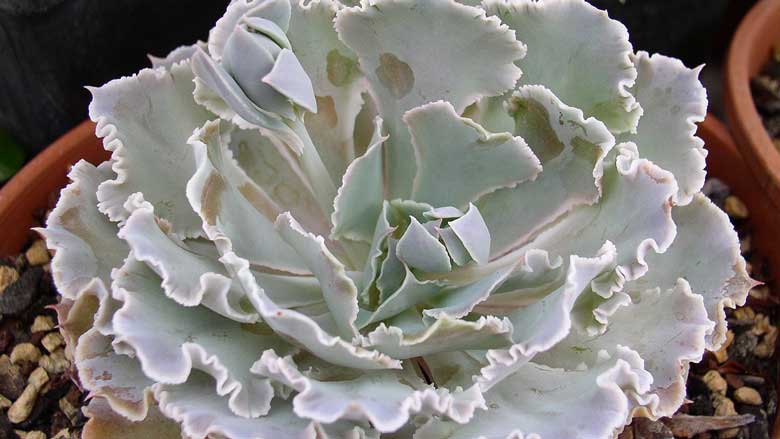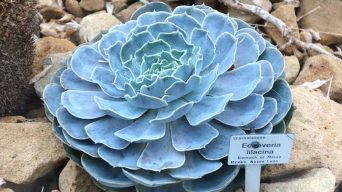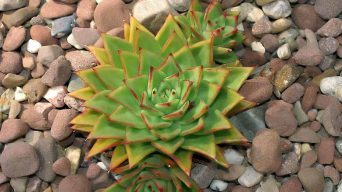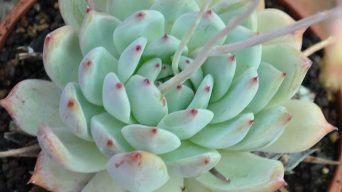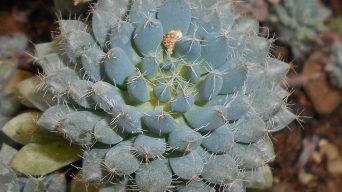Growing succulents is always fun.
They are low-maintenance, rewarding plants that anyone can grow, even if you are new to growing succulents or any other type of plant.
One of the most rewarding succulents, however, is Echeveria shaviana. It is a unique-looking plant that adds an exotic touch to your indoor or outdoor garden.
Below, you can find all you need to learn about caring for and propagating this succulent plant.
Overview
Echeveria shaviana, also known as Mexican hens or Mexican hens and chicks, is a flowering plant in the family Crassulaceae native to Mexico.
Echeveria shaviana is a beautiful succulent with grayish-green to bluish-gray rosettes of leaves with wavy and wrinkled whitish margins. In full sunlight, the leaves take on a pink tone.
The short-stemmed rosettes may reach a diameter of up to 6 inches (15 cm).
The Echeveria shaviana flowers are bell-shaped and 0.5 inches (1.3 cm) long, with a diameter of up to 0.3 inches (0.7 cm).
Pink on the outside with yellow inside, these flowers have branches that may be up to 1 foot (30 cm) long on branched stems.
How To Care for Echeveria Shaviana
Echeveria shaviana care is pretty straightforward and very rewarding. This succulent plant is unique, distinctive, and eye-catching.
Below, you’ll find the essential information you need to know about caring for Echeveria shaviana.
Sun Exposure & Light Requirements
The Echeveria shaviana plant thrives best in full sun to partial shade.
The Echeveria shaviana needs a lot of sun, but it shouldn’t get direct sunlight in the middle of the day.
To keep its beautiful color, you should not expose it for too long to strong light.
It’s best to place your succulent plant in a west or east-facing window to avoid the high temperatures of direct sunlight.
They need approximately six hours of bright light a day to stay healthy and can tolerate lower light intensities.
If you don’t want to move it around all the time, an east window in the morning and a west window in the late afternoon is perfect.
The Echeveria shaviana likes bright indirect sunlight but needs protection from the direct sun (the plant will burn!).
Watering Requirements
Watering Echeveria shaviana is a delicate matter.
Allow the soil to dry out almost completely before watering, and then soak it thoroughly to drain excess water out of the pot’s holes, but do not leave it sitting in water.
Watering frequency depends on many factors, such as humidity, temperature, type of lighting used, and plant size.
In general, water once every one to two weeks. If the soil is allowed to dry out between waterings, it should be watered thoroughly to drain excess water out of the pot’s holes and then be completely dry before re-watering.
An excellent way to test if your plant is ready for watering is to touch the top of the soil with your fingertip.
If it feels moist, it’s time to water again, but if your fingertip comes away dry or with just a little moisture, hold off until next time.
Soil Requirements
Echeveria shaviana is a plant that requires well-draining soil.
That means if you water your succulents and the excess water stays on the soil surface without evaporating, your potting mix will likely not drain well.
To ensure your soil drains well, you should use a cactus/succulent potting mix or add some coarse sand and perlite to your regular potting mix.
Echeveria shaviana is an epiphytic plant that likes air circulation around its roots. So, remember to not bury it deep in the soil or use a very heavy potting mix.
Temperature and Humidity
Echeveria shaviana requires a temperature range between 68° – 80° Fahrenheit (20 – 27°C).
At night, the ideal temperature should be around 60°F (16°C) to prevent the plant from getting cold.
It is important to avoid extreme temperature changes, so there should always be a couple of degrees of difference between day and night temperatures.
Echeveria shaviana thrives in dry places, so the humidity should be around 40%.
The plant can survive with even less humidity than this, but if the succulent leaves start to curl down, it is a sign that more humidity is required.
When grown in high humidity, these plants tend to accumulate moisture in the central part of their rosettes.
This should be avoided as it can cause rot. Also, make sure to avoid spraying water on this plant’s leaves as they are particularly susceptible to rot when wet.
Fertilizing
Echeveria shaviana is a succulent plant, which means that it does not need to be fertilized. It grows fine with no fertilizer added.
However, if you want to add fertilizer, do so sparingly and only in the growing season (summer). Use a balanced liquid fertilizer diluted to half-strength, and feed it once every two weeks.
Always use caution when fertilizing; if you add too much fertilizer, your plant will get burnt and compromise its health.
As a general rule, do not fertilize your Echeveria shaviana unless its new growth is pale or yellow.
If it looks pale, it means no nutrients are available for photosynthesis to take place, and therefore, no new material will be created from the photosynthetic process.
This will cause your plant to die.
Potting and Repotting
Echeveria shaviana are slow-growing plants, which means they should be transplanted every other year. If you want to make sure it has enough space to grow, use a one-size larger pot than the previous one.
The best time to repot Echeveria shaviana plants is in spring. Use a pot with good quality soil and enough drainage holes.
To repot, remove your succulent from the old pot. Knock away the old soil from the roots, making sure to remove any rotted or dead roots in the process.
You can lightly scrape off any of the older flat leaves with a sharp knife. Then move it to its new pot and backfill it with new fresh soil.
Ensure not to water it for a week or so, and place it in a warm and bright location.
Pruning
Pruning the Echeveria shaviana is not recommended, as this will result in stunted growth.
If you see undesired brown spots on the succulents, remove the spotted parts with a clean-cut (use sharp scissors).
You should not remove any leaves unless they are dead, damaged, or extremely shriveled.
Removing damaged and dead leaves removes a potential source of rot and infection.
Be aware that the Echeveria shaviana may lose a few lower leaves as it matures, but this is normal.
Pests and Diseases
The succulent plant Echeveria Shaviana is highly resistant to pests and diseases, but it can still be affected.
Below is a list of problems that can affect the succulent Echeveria Shaviana and how you can treat them.
Mealybugs
Mealybugs are pests that are commonly found on the Echeveria Shaviana succulent plant.
They can be identified by their white, cottony appearance and “mealy” texture.
If there are only a few of them, then you can get rid of them with just your hands or a little soap and water.
However, if they get out of control, you can use a cotton swab dipped in rubbing alcohol to get rid of them.
Aphids
Aphids are small bugs with pear-shaped bodies.
They can be identified by their green or pink color and tendency to group in bunches.
The best way to treat them is to use a cotton swab dipped in rubbing alcohol, but if they continue to bother you, remove them with your hands.
Scale
Scale bugs are pests found on almost any part of the Echeveria shaviana plant, including the leaves and stems.
They may look like tiny shells stuck to the stems, so look closely before removing them.
The best way to treat scale is to use rubbing alcohol or insecticidal soap.
Fungus Gnats
Fungus gnats are not harmful to the Echeveria Shaviana plant but can be annoying.
They are tiny black insects flying around the plant and destroying its roots by laying eggs.
If this occurs, you can use yellow sticky tape to catch them or insecticidal soap to kill them off.
Root Rot
Root Rot is caused by one of two things: over-watering or too little ventilation.
The best way to treat root rot is to water the Echeveria Shaviana less often and allow it more ventilation, but if you have been doing that and still have root rot, it could be because of a fungus.
Try repotting the Echeveria Shaviana in sterilized soil to fix root rot.
How to Care for Echeveria Shaviana in Winter
Echeveria shaviana plants grow in a dry climate and usually in the full sun.
They do not tolerate cold weather conditions well, so when caring for Echeveria shaviana plants in winter, they must be brought indoors or kept warm.
For those who live in cold climate areas where the temperature drops below freezing for at least a couple of weeks every year, the Echeveria shaviana should be brought indoors.
If you cannot bring the plant inside your house or apartment, you can at least get it away from the cold wind and drafts.
This can be achieved by placing the plant against a wall close to the door, window, or heating vent.
If you live in an area where temperatures can plummet below freezing for months, you must bring the Echeveria shaviana inside during autumn.
You may also need to protect it if there is any chance of a frost.
This can be achieved with the help of a grow light or by covering the plant with plastic sheets, which are available at most gardening stores.
Those living in areas where the temperature drops only to about 10°C (50°F) do not need to worry much about protecting their Echeveria shaviana plants during winter.
How To Propagate Echeveria Shaviana
The Echeveria Shaviana plant is easy to propagate by leaf cuttings or offsets.
Leaf Cuttings
To propagate an Echeveria Shaviana plant by leaf cuttings, follow these steps:
- You need to have at least four leaves of the parent Echeveria Shaviana plant.
- Cut off each leaf just beyond where it starts to branch out at the tip. Don’t cut off any part of the stem, just the leaf section itself.
- Let the leaves callous over for about two days. The cut area will turn white and become hard to see.
- Plant the leaves into a well-drained soil mix. The Echeveria Shaviana plant leaf should be covered with only about half an inch of soil, then water lightly.
- Place it in bright indirect light for several weeks until you notice that the leaf’s tip has sprouted roots.
- At that point, transplant the Echeveria Shaviana plant into its container with fresh soil if desired.
Offsets
Offsets are small plants that grow off of the base of an Echeveria Shaviana mother plant.
To propagate an Echeveria Shaviana plant by offsets, follow these steps:
- Find an offset to separate from the parent plant.
- Cut the offset with a sharp, sterilized blade or scissors away from the parent plant. Be sure not to damage any of the roots.
- Place the offset into potting soil and water the pot thoroughly.
- Within a few weeks to months, you should see new growth on your offset, and it can be transplanted into its permanent container if desired.
Final Thoughts
Growing succulents like the Echeveria shaviana is aesthetically pleasing, easy, and inexpensive.
With some care and basic info, your Echeveria shaviana will grow and thrive for many years.
Caring for succulents is not as time-consuming as other plants, and most of them can even survive with very little attention and effort!

